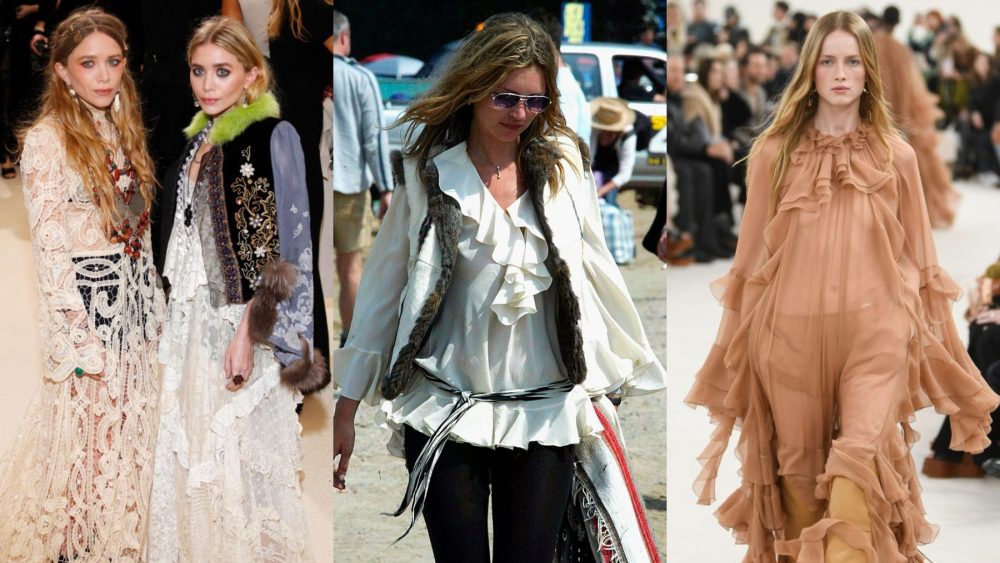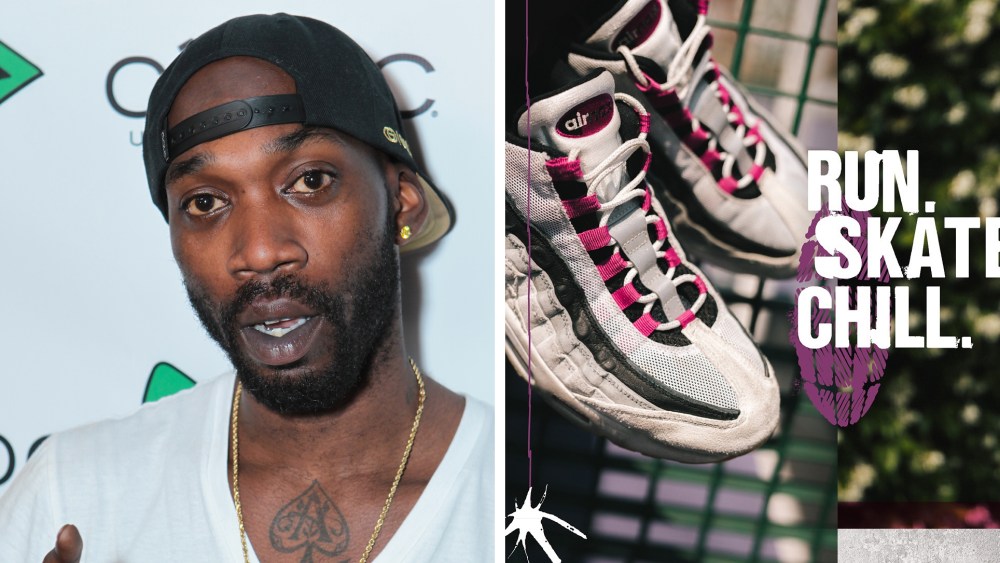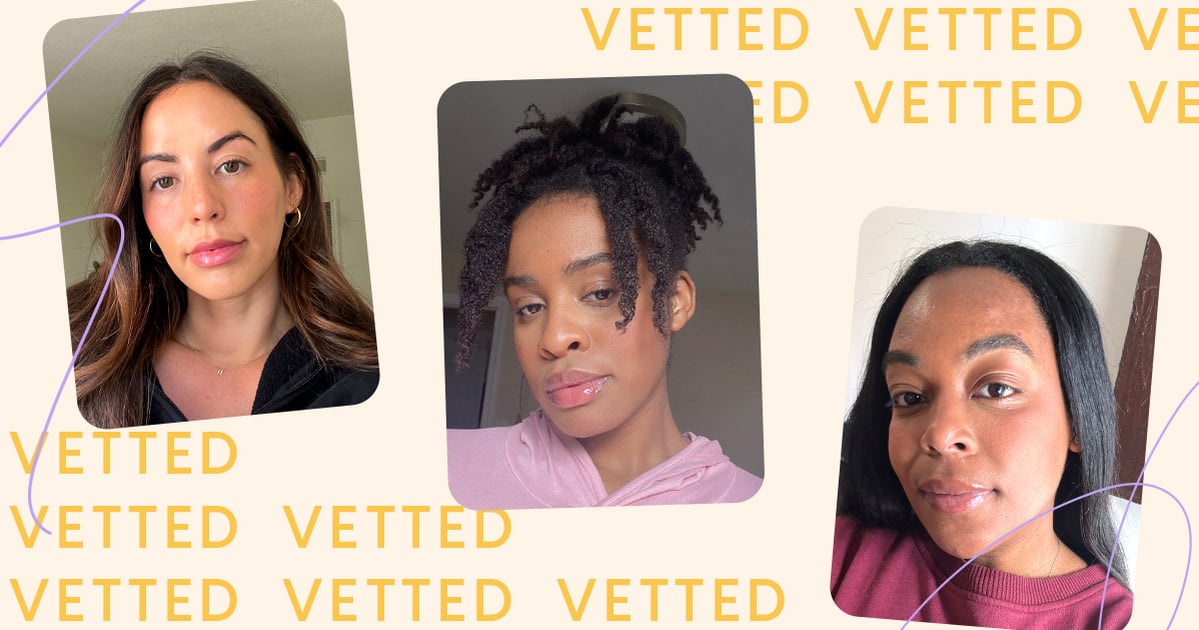Bohemian dressing dates back centuries, but it’s seen a resurgence in 2024 thanks in part to Chloé‘s recent collections. The free-spirited aesthetic is characterized by loose silhouettes, exotic prints and eclectic details (think fur vests, intricate embroideries and clamorous jewelry).
Popularized with help from stars and socialites such as Talitha Getty, Jimi Hendrix, Kate Moss and the Olsen twins, boho fashion has captured the public imagination from the painters’ canvas to the small screen. Ahead, WWD looks back at more than 200 years of bohemian style.
1800s

The term bohemian dates back to the 15th century: the French word “bohemién” was a term for the Roma people, who were thought to have migrated from the country of Bohemia, now known as the Czech Republic. By the 19th century, the term became a descriptor for struggling artists, creatives and intellectuals, many of whom congregated on Paris’ Left Bank in the Latin Quarter or Montmartre district.
You May Also Like
Some of the earliest depictions of bohemian fashion are in paintings such as Pierre-Auguste Renoir’s “In Summer,” subtitled “La Bohémienne.” This 1868 work depicts Renoir’s muse, Lise Trehot, in bohemian clothing, which typically consisted of loose-fitting silhouettes, a stark comparison to the restrictive garments favored by the upper class at the time.
1900s

Designer Paul Poiret is considered fashion’s “first great modernist” per the Metropolitan Museum of Art’s Costume Institute. After founding his house in Paris in 1903, he specialized in draping and eschewed constricting clothing like corsets and petticoats, thus disrupting the prevailing look of the Belle Époque.
Poiret borrowed styles, fabrics and motifs from Asia, North Africa, the Middle East and ancient Greece, bringing turbans, caftans, kimonos and harem pants into French fashion, and becoming one of the first Western designers to debut wide-legged trousers for women. Today, silhouettes popularized by Poiret are still heavily associated with bohemian fashion.
1960s

Bohemian fashion went mainstream in the turbulent 1960s, breaking with the traditional femininity of the post World War II period. The look of loose clothing, often worn without a bra; artful denim, and global accents became associated with individual expression and the fight for freedom and liberation as part of the Civil Rights movement, protesting the war in Vietnam, second-wave feminism and the Stonewall Uprising.
Gaby Aghion founded Chloé in 1952 as an alternative to stuffy haute couture. She brought a playful, feminine energy to her brand with help from protégés including Karl Lagerfeld, who joined the house in 1963 before he was promoted to the label’s head designer in 1966. His bold printed dresses, billowing blouses and flowing skirts introduced bohemian fashion to an entirely new audience.
The ’60s also saw the emergence of Biba, the eclectic London store founded by Polish-born designer Barbara Hulanicki. What started as a mail-order business eventually expanded to brick-and-mortar, catering to rockstar clientele such as Cher, Yoko Ono, Mick Jagger and Marianne Faithfull.

Biba revolutionized fashion by offering trendy pieces that young customers could afford, drawing upon Victorian, Edwardian, Art Deco and Art Nouveau aesthetics. The Biba look was characterized by vibrant patterns, floppy hats, platform heels and vampy makeup, which remain key elements of boho style today.
Around the same time, Talitha Getty — Dutch actress and the wife of oil heir John Paul Getty Jr. — became a bohemian style star and frequent fashion magazine subject, curating her own eclectic wardrobe from her travels to Asia and Africa.
The couple settled in Marrakech, Morocco, where Talitha became one of Yves Saint Laurent‘s many muses, and her penchant for prints, harem pants and caftans would inspire future fashion icons Phoebe Philo, Rachel Zoe and Marc Jacobs.

The 1960s also saw the birth of modern festival fashion. The era’s countercultural movement, predominantly led by teenagers and young adults, culminated in hippies converging in upstate New York for Woodstock in 1969, where maxidresses, caftans, loose silhouettes and folkloric clothing were worn by headliners Janis Joplin and Jimi Hendrix, as well as those in the crowd.
Growing environmental consciousness led to an interest in sustainable fashion. Hippies often customized handmade or thrifted clothing using DIY techniques like tie dye, patchwork and macramé. They also had an interest in Eastern and Native American cultures, wearing traditional garments like buckskins, kurtas and pashtun vests. Some may have also acquired chic souvenirs while trekking the “hippie trail,” which extended across Turkey, Afghanistan, Nepal, India and Thailand.

1970s

By the 1970s, boho styles were all over the runway, with Yves Saint Laurent’s fall 1976 couture show being a notable highlight. The Ballet Russes collection featured models dressed in folkloric blouses, vests, voluminous skirts and head wraps in colorful silks, velvets and gold lamé, borrowing inspiration from Sergei Diaghilev’s dance company of the same name.
Diaghilev’s elaborate productions with costumes by Leon Bakst, who was the troupe’s main designer for close to a decade, presented a romanticized view of old Russia to a European audience. They were enormously influential, inspiring Poiret among others, and drew in as collaborators such as Coco Chanel, Pablo Picasso and Joan Miró.
Boho staples such as vests (both fur and gold-trimmed), flowy printed blouses, jewel-toned headwraps and diaphanous skirts were key elements of Saint Laurent’s Ballet Russes collection.

Stevie Nicks joined Fleetwood Mac in 1974, helping the band achieve mainstream success with their eponymous 1975 album. Nicks tapped the talents of designer Margi Kent to curate her bohemian wardrobe, which frequently consisted of fringe shawls, chiffon skirts and suede platform boots — a look that would be replicated by designers such as Anna Sui, Michael Kors and Hedi Slimane at Saint Laurent.
Nicks also shopped for tunic tops and bell-bottoms at the now-defunct Velvet Underground boutique in San Francisco. Two of her musical idols, Janis Joplin and Jefferson Airplane’s Grace Slick, were frequent customers.
1990s

Boho saw a major resurgence in the 1990s as a slew of young designers built brands on the aesthetic, which was embraced by young Hollywood.
1994 marked the launch of Isabel Marant’s namesake brand. The French fashion designer would make boho styles a linchpin of her work, incorporating fringe, patchwork and embroidery throughout her collections.
The NBC sitcom “Friends” also premiered that year, introducing the bohemian style of Phoebe Buffay to the masses. The kooky personality of Lisa Kudrow’s character was reflected in her eclectic outfits, dreamed up by costume designer Debra McGuire, a self-proclaimed ex-hippie.
“I didn’t want it to be sort of bringing back something,” McGuire told Entertainment Weekly of designing Phoebe’s costumes in 2019. “I wanted it to be reminiscent of bohemian life, but I wanted it to have a more contemporary feeling.”
McGuire created this vibe by taking inspiration from boho style icon Stevie Nicks, curating a ’70s-meets-’90s wardrobe that comprised fluid maxiskirts, floral prints and layered jewelry.

Tom Ford joined the house of Gucci in 1990, but it wasn’t until 1995 that he made waves in the fashion world, debuting a ’70s-inspired collection featuring fuzzy outerwear, velvet trousers and jewel-toned satin shirts. The designer looked a few years back for his spring 1999 presentation, debuting “hippie-chic” designs that played on the Summer of Love.
Ford’s vibrant florals were indeed considered groundbreaking, with the designer splashing them across dresses, bikinis, low-slung pants and skirts. Mirror work tops, feathered denim and fringe accents also contributed to Gucci’s undeniably boho-coded collection.
2000s

Enter the “boho chic” era of the early aughts, when famous Glastonbury attendees Kate Moss and Sienna Miller popularized hippie-inspired fashions at festivals. Coin belts, fur outerwear, ruffled blouses, floaty skirts and embroidered tunics were commonly associated with the 2000s boho look.
Moss credits the influence of Anita Pallenberg, whom she called “the original bohemian rock chick” in the 2023 documentary “Catching Fire.” Pallenberg, the longtime partner of The Rolling Stones’ Keith Richards, imbued the rock band with her signature sense of style, which included a heavy rotation of funky prints and peasant tops. Richards was even known to borrow many of Pallenberg’s clothes.
Meanwhile, across the pond, stars like Mary-Kate and Ashley Olsen and Rachel Zoe brought boho chic stateside. Zoe turned her celebrity clients — Nicole Richie, Mischa Barton and Lindsay Lohan, among others — into red carpet clones, dressing them in the billowing maxidresses and statement accessories, read: wide-brimmed hats, bug-eyed sunglasses and chunky jewelry she loved herself.

The impact of boho chic reverberated on the runway, at Tom Ford’s Gucci and Yves Saint Laurent, Phoebe Philo’s Chloé, Roberto Cavalli, Tory Burch, who launched her famous tunic in 2004, and many more.
“It’s our ultimate fantasy right now to be a Kate Moss or Sienna Miller,” Anna Sui told WWD in 2004. “To be able to have the luxury of being that glamorous, but also have that whole throwaway look. There’s a dressing-down quality, and people can relate to fashion that way.”
2010s

Boho style transfixed the small screen once again with the premiere of “Gossip Girl” in 2007. The wardrobe of Blake Lively’s Serena van der Woodsen, per the show’s costume designer Eric Daman, was heavily inspired by Kate Moss.
“Serena would be much more international, bohemian; she’s almost like a bird that was traveling and just picking up things throughout Europe and had this very different, easy-going nonchalance about her,” Daman told Fashionista in 2017.
Florence Welch became a household name with the release of her 2009 album “Lungs.” The singer was also one of the progenitors of 2010s boho fashion, becoming a muse to Karl Lagerfeld, Alessandro Michele of Gucci and Emma Hill of Mulberry.

Welch’s penchant for romantic silhouettes and flowing dresses solidified her status as bohemian style icon. The “Dog Days Are Over” artist developed her sense of style from playing dress-up and shopping at thrift stores in her youth.
Although Welch’s relationship with Gucci dated back to when Frida Giannini was still the label’s creative director, she quickly bonded with Michele when he took the helm in 2015. Giannini had dressed Welch in custom Gucci for her 2011 tour, a tradition that Michele would continue.
“I feel like he’s a real kindred spirit,” Welch told WWD of Michele in 2016. “We are drawn to a lot of similar themes — the Baroque, the Renaissance, Greek mythology….He makes clothes you want to wear. He’s just creating a world. I love the iconography that’s based in nature — the flowers, all the little animals, even the bamboo and the horseshoes and snakes really appeal to me.”

The Coachella Valley Music and Arts Festival also served as a breeding ground for boho fashion in the 2010s. Attendance rates skyrocketed throughout the decade, while stars including Kendall Jenner, Alessandra Ambrosio, Gigi Hadid and Vanessa Hudgens popularized a new festival uniform that seamlessly blended bohemian and Western influences with on-trend pieces like off-the-shoulder blouses, denim cutoffs and flower crowns.
2020s

Chemena Kamali made her runway debut as the creative director of Chloé during the fall 2024 season, singlehandedly reviving the boho trend by looking back to the 1970s.
“It’s a period I find extremely relevant because a lot of the codes and values were established in that era,” Kamali told WWD. “It was so much about joy and freedom.”
Stars including Sydney Sweeney and Daisy Edgar-Jones carried Kamali’s first Chloé collection from the catwalk to the streets of Beverly Hills and New York, while Zoe Saldaña and Greta Gerwig modeled ethereal looks designed by Kamali at the “Garden of Time”-themed Met Gala this year.
Sienna Miller also returned to her boho roots on the red carpet, promoting her new film “Horizon: An American Saga” in Chloé fall 2024 designs at the Cannes and Venice Film Festivals.

Throughout her “Eras Tour,” Taylor Swift embraced bohemian fashion with help from designer Alberta Ferretti, who dreamed up the looks for her “Folkmore” set, which features a combination of songs from her albums “Folklore” and “Evermore.”
Ferretti designed romantic dresses with ruffles, lace panels, caped sleeves and tiered skirts for the Grammy-winning singer, taking inspiration from her own archives.
The boho trend continued to captivate designers during the spring 2025 runway season, with labels such as Saint Laurent, Ralph Lauren and Isabel Marant proving that the fad is far from finished.


